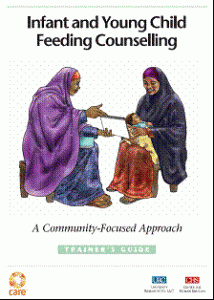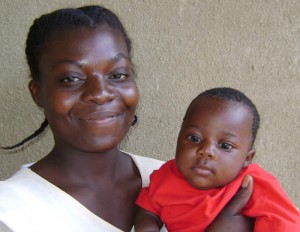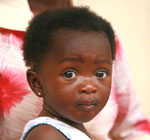Community-based approaches are an important part of a comprehensive program to improve infant feeding and nutrition. A wide range of partners are implementing innovative community-based strategies that are linking communities with vital health care services and helping prevent malnutrition. The Infant & Young Child Nutrition Project has started gathering some of these examples to share experiences, lessons learned, good practices, and results. Read below to learn about the successful community-based approaches that various organizations are implementing to promote infant feeding and nutrition.
View community-based approaches
- Child feeding bowl: a simple tool to improve nutrition
- Grandmothers improve their approach to treating sick children in Laos
- Safer Breastfeeding Programme protects babies from HIV in South Africa
- Harnessing the power of mother-to-mother support groups in Kenya’s refugee camps
- Enhancing community-based child growth promotion in Zambia
Child feeding bowl: a simple tool to improve nutrition
The Manoff Group developed a simple, low-cost solution to a persistent problem in young child feeding: children being fed an inadequate amount at each meal. To raise awareness and guide caregivers about how much children should eat, The Manoff Group designed a child feeding bowl specially marked with measurements denoting the appropriate amount of food for each age. Already popular with mothers in Nicaragua and El Salvador, the bowl was pretested in Bolivia with mothers of children aged 6–24 months. Results showed that the bowl enabled mothers to increase the quantity of food the child consumed. Use of the bowl seemed to motivate other practices as well, such as feeding more frequently and keeping the child’s food separate from that of the rest of the family. An unexpected result was that older children took ownership of their bowls and asked for food.
Visit The Manoff Group’s website to learn more.
View a presentation on the child feeding bowl from the 2009 Global Health Council Conference.
Grandmothers improve their approach to treating sick children in Laos
In 1997, the World Health Organization, the United Nations Children’s Fund, and the Institute of Maternal and Child Health worked in Vientiane, Laos, to include grandmothers as family health advisors in a strategy to improve household care of sick children. In many developing countries, senior women play a critical role in community and family life, especially in advising and educating younger women on all aspects of family well-being. But despite the strong influence of grandmothers, community health and education programs typically focus on women of childbearing age and their children and exclude senior women.
The strategy focused on improving grandmothers’ knowledge of how to treat diarrhea, including good infant feeding practices. In the past, many Laotian families believed that a child with diarrhea should not be given fluids because that would increase the diarrhea. Such beliefs contribute to the deaths of many children due to dehydration. The participation of grandmothers led to improved household care for diarrhea, reducing risk of childhood death. Grandmothers’ knowledge of optimal home treatment strategies increased significantly, as did their confidence in their role as family health advisors. Other family members strongly supported the fact that the strategy acknowledged the role of grandmothers in families and that it made them more effective in that role.
The implementers found that there were positive improvements in grandmothers’ knowledge and advice to other family members. In the baseline study, only 30 percent of the grandmothers said that they advised giving “lots of fluids” to a child with diarrhea, whereas in the endline study, 74 percent of grandmothers were giving this beneficial advice. Similarly, the proportion of grandmothers who advised mothers with young children to continue breastfeeding during diarrhea increased greatly, from 73 percent at the beginning of the project to 90 percent at end of the project.
Safer Breastfeeding Programme protects babies from HIV in South Africa
In January 2000, investigators at the University of KwaZulu-Natal introduced the Safer Breastfeeding Programme, an approach to promote exclusive breastfeeding and reduce HIV transmission from mothers to infants in high HIV prevalence areas in the KwaZulu-Natal Province of South Africa. As part of a comprehensive prevention of mother-to-child transmission strategy, the program identified community leaders and trained them extensively as breastfeeding counselors. The breastfeeding counselors provided ongoing home-based infant feeding support for HIV-positive mothers. To avoid stigma for HIV-positive women, counselors also supported HIV-negative breastfeeding women in the community.
Implementers of this approach have found that carefully selected, trained, and supported lay counselors offer a potentially economical alternative to improve infant feeding—compared to relying on overburdened health workers. Implementers have observed a low HIV transmission rate of 2.6 percent for breastfeeding up to 9 months of age. In addition, mothers participating in the program have experienced fewer difficulties with breastfeeding, such as breast pathologies that are known to increase HIV transmission, than is usually reported by HIV-positive women. This successful community-based model has been replicated by several organizations, including the Africa Centre for Health and Population Studies.
Sources:
Bland et al. Intervention to promote exclusive breast-feeding for the first 6 months of life in a high HIV prevalence area. AIDS. 2008;22:883–891.
Coutsoudis A. Infant Feeding Dilemmas Created by HIV: South African Experiences.Journal of Nutrition. 2005;1315:956–959.
Harnessing the power of mother-to-mother support groups in Kenya ’s refugee camps
Since 2005, the Dadaab Infant and Young Child Feeding Team, an interagency collaboration, has provided support for infant and young child feeding in three refugee camps in Dadaab, Kenya. The camps are home to more than 240,000 refugees, many of whom have a low level of literacy.
 The team, which includes CARE, the United Nations High Commissioner for Refugees, GTZ (German Agency for Technical Cooperation), the International Rescue Committee, the National Council of Churches of Kenya, and other partners, developed a mother-to-mother support group strategy as part of its efforts to improve infant and young child feeding in the camps. The partners have found that mother-to-mother support groups are an effective way to harness the collective power of women as agents of change in the community. Support groups empower women to make better decisions and build self-confidence.1
The team, which includes CARE, the United Nations High Commissioner for Refugees, GTZ (German Agency for Technical Cooperation), the International Rescue Committee, the National Council of Churches of Kenya, and other partners, developed a mother-to-mother support group strategy as part of its efforts to improve infant and young child feeding in the camps. The partners have found that mother-to-mother support groups are an effective way to harness the collective power of women as agents of change in the community. Support groups empower women to make better decisions and build self-confidence.1
Facilitators of mother-to-mother support groups come from a cadre of women living in the camps. The support group facilitators are peers who speak the same language as other mothers and are known and trusted in the community. They are trained for more than 4.5 days using a training package developed in Dadaab for lower-literacy workers: Preparation of Trainer’s Course: Mother-to-Mother Support Group Methodology and Breastfeeding and Complementary Feeding Basics. The package builds on materials from the training curriculum Infant and Young Child Feeding Counselling: A Community-Focused Approach, developed in collaboration with University Research Co., LLC, and its nonprofit affiliate, the Center for Human Services, which includes an integrated set of 18 counseling cards.
To overcome the challenge of training camp workers who speak many different languages, the team developed low-literacy pictorial training materials and carried out ongoing orientation and capacity-building trainings in order to keep all the staff up to date and in the loop.
The implementers have found that the support groups have spread rapidly. So far, there are 679 active groups in the camps—all started by women in Dadaab themselves. Team members have observed women taking ownership of the groups and taking initiative to support other mothers to improve infant feeding practices.
Download the training tools mentioned above.
Read a Q&A with CARE team members about their work to improve infant feeding in Dadaab.
1 The Johns Hopkins University Population Communication Services Community Mobilization Task Force Bulletin. May 1999. The Mobilizer, Volume 2: Issue 1.
Enhancing community-based child growth promotion in Zambia
Community-based child growth promotion was an effective part of the Primary Health Care Project, a successful project to establish a community-based model of primary health care in the unplanned settlements of Lusaka, Zambia. From 1997 to 2007, the project, implemented by the Lusaka District Health Management Team of the Ministry of Health and the government of Zambia, in close collaboration with the Japan International Cooperation Agency, produced tangible results in the improvement of the health status of children younger than 5 years.
 The project’s Growth Monitoring Programme Plus (GMP+) enhanced community-based growth promotion in all six health center catchment areas targeted. The program included weighing of children as an entry point to health education, nutrition counseling, soybean promotion, community referral, immunization, family planning, micronutrient supplementation, and deworming. Implementers used a six-week training program for community health workers and a two-week program for nutrition promoters. The volunteers became the backbone of the GMP+ activities. Due to shortages of health center staff, the volunteers implemented these sessions themselves, under the supervision of community health coordinators who had completed a five-day training course and who worked closely with the community. As a result, more GMP+ sessions were held.
The project’s Growth Monitoring Programme Plus (GMP+) enhanced community-based growth promotion in all six health center catchment areas targeted. The program included weighing of children as an entry point to health education, nutrition counseling, soybean promotion, community referral, immunization, family planning, micronutrient supplementation, and deworming. Implementers used a six-week training program for community health workers and a two-week program for nutrition promoters. The volunteers became the backbone of the GMP+ activities. Due to shortages of health center staff, the volunteers implemented these sessions themselves, under the supervision of community health coordinators who had completed a five-day training course and who worked closely with the community. As a result, more GMP+ sessions were held.
Through the implementation of various GMP+ community health interventions, along with the project’s community referral and environmental health activities, the health status of children younger than 5 years improved in the six target areas. The project’s final evaluation was conducted in January 2007. Results included a decline in the number of malnutrition cases from 72.4 per 1,000 population (2002) to 21.6 (2006). In addition, the percentage of children younger than 5 years who were below the growth line dropped from 14.8 percent (2002) to 10 percent (2006).
Visit the Japan International Cooperation Agency website to learn more.
Date: Jul 22, 2009 | Category: Announcements

